

Table of Contents
Background
In the early 20th century, the world found itself in a global conflict. World War I, or the Great War as it was known at the time, lasted from 1914 to 1918, pitching Central Powers (Germany, Austro-Hungary, Ottoman Empire) versus the Entente/Allied Powers (Russia, France, Britain, and later the US), with a myriad of smaller allies on both sides. Without going into the question of reasons and causes of the war, many fighting at the time thought of it as a “war to end all wars”, a notion which proved to be too idealistic. Part of this was caused by the faultiness of the peace treaties that came after it.
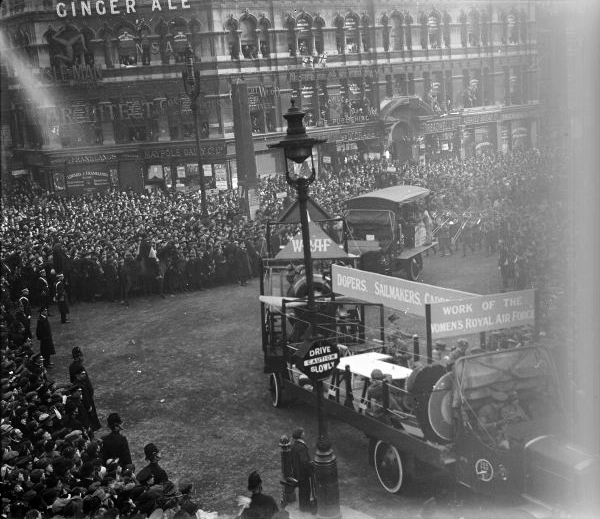
The WRAF on parade in London at the end of World War I, 1918. WikiCommons
Road to “peace”
The Great War was a bloody conflict, the largest up to that date, which many consider having ended on November 11th 1918 when Germany surrendered. However, this is a simplified portrait of the war’s ending. Before Germany, other nations signed their separate peace armistices. First was Russia in March of 1918, as it went through an internal revolution that led to the formation of the Soviet Union. It signed a separate peace with the Central Powers, leaving vast territories in East Europe to Germany and Austro-Hungary, as well as parts of the Caucasus to the Ottomans. The fate of these European lands, encompassing Finland, the Baltic states, Belarus, Ukraine, and Poland was to be solved in the future. However, though with this Central Forces seemed to have gained substantially with this, the war fortunes quickly overturned as the Allies began major offensives during the summer. These eventually led to sequential surrenders started by Bulgaria (September 29th), Ottoman Empire (October 31st), Austro-Hungary (November 3rd), finally leading to Germany. With this, fighting was factually finished. However, in strictly legal terms, it was not the end of the war. All the treaties signed by the Central Powers were officially armistices. Thus, after the truce was created, peace needed to be forged.
Attempt to achieve that was made during the Paris Peace Conference which started in January of 1919. A large number of states, as well in some cases colonies, were officially represented. Among them, most important were the so-called “Big Five”, major Allied Powers which basically led the conference – Great Britain, France, United States, Italy, and Japan. However, Japan’s role quickly diminished, leaving the peace conference in the hand of the “Big Four”. Besides the official delegations, many nations, peoples, and organizations, some of which weren’t yet internationally recognized at the time, sent their representatives to Paris in an attempt to lobby for their own political and national interests. The conference itself was a complicated mesh weaved from dozens of commissions, hundreds of sessions, thousands of discussions, and meetings, making it rather difficult to outline. Nonetheless, some basic generalizations can be made. The goal of the conference was to ensure lasting peace, with two major currents of thought on how to achieve that.
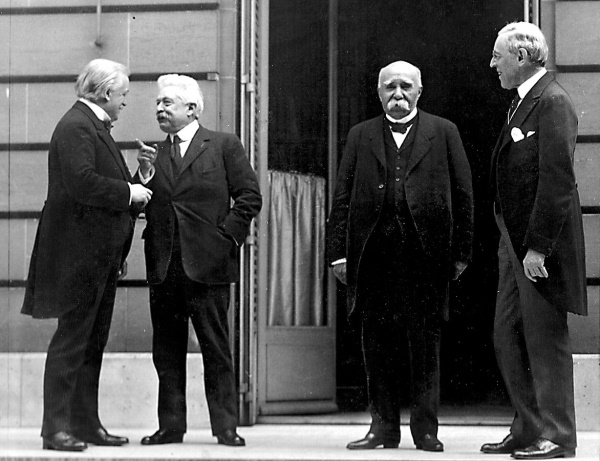
‘The Big Four’ (from left to right, David Lloyd George of Britain, Vittorio Emanuele Orlando of Italy, Georges Clemenceau of France, and Woodrow Wilson of the United States) - WikiCommons
One was pragmatist view heralded by the French Prime Minister George Clemenceau, who ascertained that the only way to prevent any future large conflicts was to weaken Germany and other Central Powers so they posed no more threat. On the other side of the specter was the idealism of the US president Woodrow Wilson, who hoped that peace could be achieved if the old imperial “balance of powers” diplomacy was to be replaced by a more “democratic” international relations based on equality, self-determination and free trade, safeguarded by the international law and organizations. Britain, led by David Lloyd George, found itself somewhat in between, as it sought to punish Germany, yet not too harshly, while also dealing with various territorial disputes in terms of realpolitik. At the same time, Britain supported the idea of international law and organizations as the basis of diplomacy but had a somewhat tougher stance towards the idea of self-determination due to its vast colonial empire. Other delegations had followed much narrower goals, set by their national interests.
Despite that, after much deliberation, the Paris Peace Conference produced peace through several treaties, the first being the Versailles Treaty signed in June 1919 with Germany, becoming a symbol of the conference. Many see it as either official or unofficial end of the conference, as most leaders stopped their active participation in Paris afterward, yet other treaties ensued. In September with Austria, November with Bulgaria, while the Hungarians and the Ottomans signed their treaties in 1920, in June and August, respectively.
Flag of the League of Nations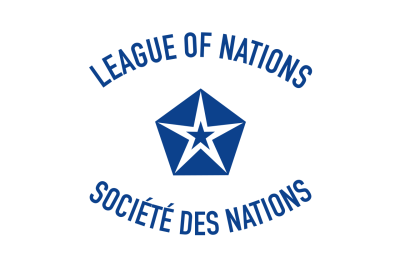
Restlessness within harmony
All these treaties led to some major territorial changes across the globe. In Europe, Germany lost Alsace-Lorrain to France (which it won in 1871 Franco-Prussian War) in the west, as well as considerable provinces in the east to newly liberated Poland – including Posen, Eastern Pomerania, and parts of Upper Silesia. Austro-Hungary was divided into two separate countries, while also losing significant portions of their territories. From those, parts went to Italy, Romania, and Poland, while it also led to the formation of Czechoslovakia. In the Balkans, southern regions of Austro-Hungary became part of the Kingdom of Slovenes, Croatians, and Serb, later dubbed Yugoslavia. Greece also took possessions of parts of Bulgaria and Turkey. The Ottoman Empire became the Republic of Turkey, based around the territories of Asia Minor, while the rest of the lands were mostly split between France and Britain in various forms of mandates and colonial control. As for the German colonies, parts were also awarded to French, Belgian, and British control. Some were also ceded to members of the British Commonwealth like Australia or South Africa, while minor territories were given to Italy and Portugal. German possessions in China were awarded Japan.
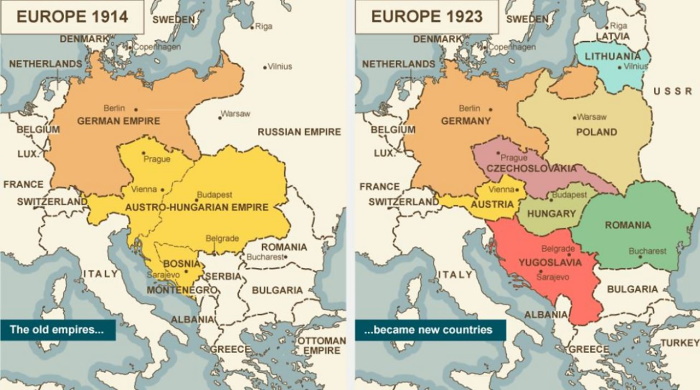
Map of major territorial changes in Europe after the World War I - BBC
Apart from territorial losses, the defeated had to pay substantial reparations, which proved to be a significant issue for economies worn-out by war. Some were to be paid in gold or currency, others in various goods like food or coal. This led to further strain on the economy of the defeated as well as to the accumulation of foreign loans. Furthermore, all the former Central Powers had been imposed with restrictions of their military might, to prevent them from starting a new conflict. All the mentioned decisions were followed by numerous other minor provisions, but one stood out especially. It was part of the Versailles Treaty which stipulated German admission of guilt for causing the war. For many Germans it was a bitter pill, as it was perceived as a national disgrace.
Combining considerable territorial losses, imposed reparations, and blame for the war itself would doubtlessly be enough to cause frustration and dissatisfaction with the peace treaty. Topping all that was the fact that none of the defeated parties had any representatives in Paris, as the agreements were more or less forced upon them without any negotiation through the threat of resumed war. This was most notable in the German case but other defeated nations suffered similar fates, though Turkey managed to win back some of its losses through a war that was concluded in 1923. Even worse, many of the victors were unsatisfied with the results of the conference. Italy received only parts of the territories it was promised in 1915 to join the war, as large chunks went to Yugoslavia. Japan was unsatisfied because it was treated as a second-class nation, as its proposal for an amendment on racial equality in the founding charter of the League of Nations was rejected. On the other hand, China was dissatisfied by the fact that German colonies on its mainland were awarded to Japan instead of been given the right to self-determination.
Even the major victors had issues with the treaties. For many of the French, Germany was insufficiently punished, while parts of the British public thought it was too severe. However, the worst reception was in the US. Although Wilson was a champion for both the League and the idea of national self-determination, the cornerstone ideas of the Conference, the majority of the American public was against it. Thus, Congress refused to ratify any of the agreements the president brought back, leaving the US out of all commitments it agreed upon.
Breather between two conflicts
The ultimate goal of the Paris conference was to ensure long-lasting peace. From a modern perspective, it is clear it failed as World War II erupted in 1939 (or in 1937 if Japan’s attack on China is considered). Though it is far from a simple answer to why the peace lasted barely 20 years, there are certain root causes embedded in the Paris peace treaties. First of all, the war left most of the European economies shattered, while the reparations made it even worse for the defeated. The Conference never thought seriously about how to deal with that. While later economic crisis built upon it, the poverty and instability proved to be a fertile ground for the rise of nationalists and fascists who prayed upon dissatisfaction and misery of the common people. These ideals were only heated up by Wilsonian national self-determination, which in a way hinted at a possibility of “nationally pure” states. Of course, complicated population distribution, mixed societies, and historical development made that rather impossible. Building upon that was the fact that many nations felt robbed of the territories that “belonged” to them, a clear result of the peace treaties.
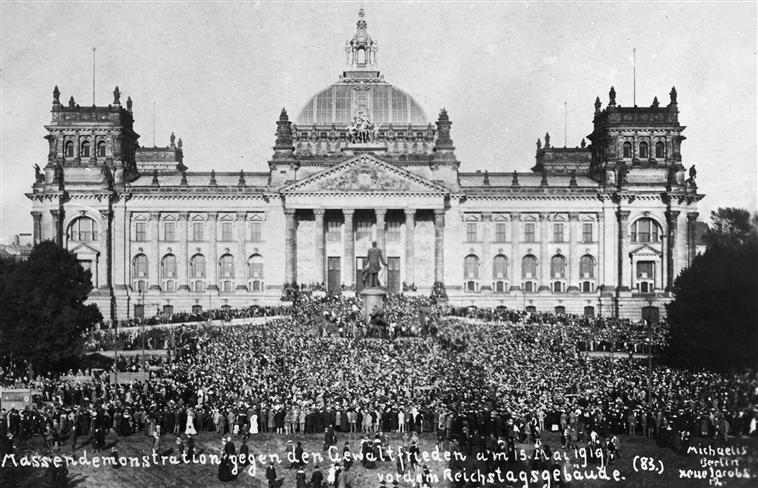
Mass demonstration in front of the German Reichstag against treaty of Versailles in 1919
To make matters worse, the League of Nations which was supposed to deal with such challenges to peace had no factual capacity to tackle it. It had no funds, sub-organizations, military nor any real support from the major members. As such, it was mostly limited to the role of a spectator that could only condemn perceived transgressions. Another issue with the Conference was its stance towards events in Russia. A civil war that raged on there meant no official representatives were present in Paris, while the major nations felt threatened by the winning Bolsheviks and their communist ideology. Thus, the conference was partially aimed at containing communism by reinforcing nationalism and creating larger states on Russian borders. However, the conference never actually tried to settle borders in the east, nor officially recognize nations formerly under Imperial Russia like Ukraine or Georgia. Therefore, the Soviet Union perceived the west as a threat, making them part of the nations who saw the Conference as injustice aimed against them.
Final words
Mentioned national frustrations piled up over the years, enhanced by various events of the interwar period. That was enough to make Germany, Italy, Hungary, Bulgaria, and others succumb to nationalistic governments who sought to “right the wrongs” through yet another war. For Japan, the added feeling of racial and national discrimination towards the Asians fueled more discontent, swaying towards nationalism. Overall, a strong sentiment among the policies of the mentioned nations was the revision of the Paris Peace Conference. Thus, not only the Conference failed to form an enduring peace, in an indirect way it proved to be a partial cause for World War II, making it a strong candidate for a diplomatic disaster of the century.
Online sources
Sources/Further reading
-
Alston C., ‘The Suggested Basis for a Russian Federal Republic’: Britain, Anti-Bolshevik Russia and the Border States at the Paris Peace Conference, 1919, History, Vol. 91, No. 1 (301) (January 2006), pp. 24-44.
-
David A. Andelman, A Shattered peace: Versailles 1919 and the price we pay today, John Wiley & Sons, 2008.
-
Fink, C., The Paris Peace Conference and The Question of Minority Rights, Peace & Change, 21(3), 1996, 273–288.
-
Kennan G., Russia and the Versailles Conference, The American Scholar, Vol. 30, No. 1 (Winter, 1960-61), pp. 13-42.
-
Lauren, P. G., Human Rights in History Diplomacy and Racial Equality at The Paris Peace Conference, Diplomatic History, 2(3), 1978, pp 257–278_._
-
Lisa L. Beckenbaugh, Treaty of Versailles: A primary document analysis, ABC-CLIO, 2019.
-
Louise C. Slavicek, The Treaty of Versailles, Infobase Publishing, 2010.
-
M. Dockrill and J. Fisher, The Paris Peace Conference 1919: peace without victory?, Palgrave Publishers, 2001.
-
Manfred F. Boemeke, … [et al.], The Treaty of Versailles: a reassessment after 75 years, Cambridge University Press, 1998.
-
Michael S. Neiberg, The Treaty of Versailles: a concise history, Oxford University Press, 2017.
-
N. A. Graebner and E. M. Bennett, The Versailles Treaty and its legacy: the failure of the Wilsonian vision, Cambridge University Press, 2011.
-
Trachtenberg, M., Reparation at the Paris Peace Conference, The Journal of Modern History, 51(1), 1979, pp 24–55.
